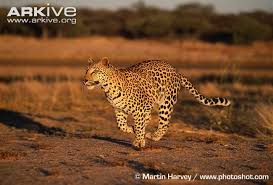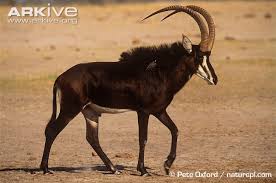Post by dinosauria101 on Aug 8, 2019 17:59:57 GMT 5
Leopard - Panthera pardus
The leopard, Panthera pardus, is a member of the Felidae family and the smallest of the four "big cats" in the genus Panthera, the other three being the tiger, lion, and jaguar. The leopard was once distributed across eastern and southern Asia and Africa, from Siberia to South Africa, but its range of distribution has decreased radically because of hunting and loss of habitat. It is now chiefly found in sub-Saharan Africa; there are also fragmented populations in Indonesia, Pakistan, India, Sri Lanka, Indochina, Malaysia, and China. Because of its declining range and population, it is listed as a "Near Threatened" species by the IUCN. Leopard are agile and stealthy predators. Although smaller than other members of the Panthera genus, they are able to take large prey due to their massive skulls that facilitate powerful jaw muscles. Head and body length is between 125 and 165 cm (49 and 65 in), and the tail reaches 60 to 110 cm (24 to 43 in). Shoulder height is 45 to 80 cm (18 to 31 in). The muscles attached to the scapula are exceptionally strong, which enhance their ability to climb trees. They show a great diversity in size. Males are about 30% larger than females, weighing 30 to 91 kg (66 to 200 lb) compared to 23 to 60 kg (51 to 130 lb) for females. Large males of up to 91 lb (41 kg) have been documented in Kruger National Park in South Africa; however, males in the South Africa's coastal mountains average 31 lb (14 kg). This wide variation in size is thought to result from the quality and availability of prey found in each habitat. Smaller sized leopards also are known in the deserts of the Middle East. Its body is comparatively long, and its legs are short.

Sable Antelope - Hippotragus niger
The sable antelope (Hippotragus niger) is an antelope which inhabits wooded savannah in East Africa south of Kenya, and in Southern Africa, with a population in Angola. The sable antelope is sexually dimorphic, with the male heavier and about one-fifth taller than the female. The head-and-body length is typically between 190 and 255 cm (75 and 100 in). Males reach about 117–140 cm (46–55 in) at the shoulder, while females are slightly shorter. Males typically weigh 235 kg (518 lb) and females 220 kg (490 lb). The tail is 40–75 cm (16–30 in) long, with a tuft at the end. Sable antelope live in savanna woodlands and grasslands during the dry season, where they eat mid-length grasses and leaves. They visit salt licks and have been known to chew bones to collect minerals. They are diurnal, but are less active during the heat of the day. They form herds of 10 to 30 females and calves led by a single male, called a bull. Males fight among themselves; they drop to their knees and use their horns.

Credit to Wikipedia
The leopard, Panthera pardus, is a member of the Felidae family and the smallest of the four "big cats" in the genus Panthera, the other three being the tiger, lion, and jaguar. The leopard was once distributed across eastern and southern Asia and Africa, from Siberia to South Africa, but its range of distribution has decreased radically because of hunting and loss of habitat. It is now chiefly found in sub-Saharan Africa; there are also fragmented populations in Indonesia, Pakistan, India, Sri Lanka, Indochina, Malaysia, and China. Because of its declining range and population, it is listed as a "Near Threatened" species by the IUCN. Leopard are agile and stealthy predators. Although smaller than other members of the Panthera genus, they are able to take large prey due to their massive skulls that facilitate powerful jaw muscles. Head and body length is between 125 and 165 cm (49 and 65 in), and the tail reaches 60 to 110 cm (24 to 43 in). Shoulder height is 45 to 80 cm (18 to 31 in). The muscles attached to the scapula are exceptionally strong, which enhance their ability to climb trees. They show a great diversity in size. Males are about 30% larger than females, weighing 30 to 91 kg (66 to 200 lb) compared to 23 to 60 kg (51 to 130 lb) for females. Large males of up to 91 lb (41 kg) have been documented in Kruger National Park in South Africa; however, males in the South Africa's coastal mountains average 31 lb (14 kg). This wide variation in size is thought to result from the quality and availability of prey found in each habitat. Smaller sized leopards also are known in the deserts of the Middle East. Its body is comparatively long, and its legs are short.
Sable Antelope - Hippotragus niger
The sable antelope (Hippotragus niger) is an antelope which inhabits wooded savannah in East Africa south of Kenya, and in Southern Africa, with a population in Angola. The sable antelope is sexually dimorphic, with the male heavier and about one-fifth taller than the female. The head-and-body length is typically between 190 and 255 cm (75 and 100 in). Males reach about 117–140 cm (46–55 in) at the shoulder, while females are slightly shorter. Males typically weigh 235 kg (518 lb) and females 220 kg (490 lb). The tail is 40–75 cm (16–30 in) long, with a tuft at the end. Sable antelope live in savanna woodlands and grasslands during the dry season, where they eat mid-length grasses and leaves. They visit salt licks and have been known to chew bones to collect minerals. They are diurnal, but are less active during the heat of the day. They form herds of 10 to 30 females and calves led by a single male, called a bull. Males fight among themselves; they drop to their knees and use their horns.
Credit to Wikipedia


